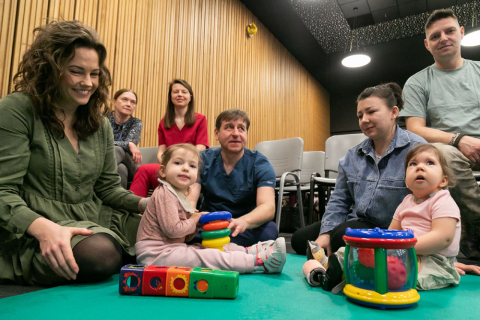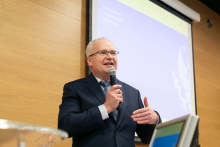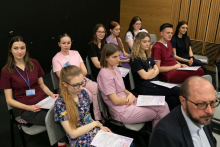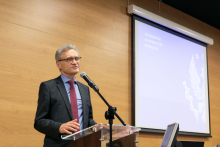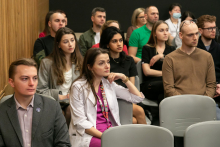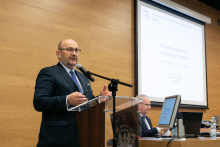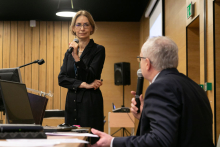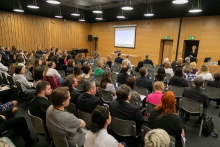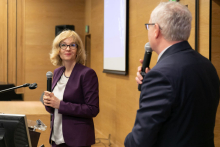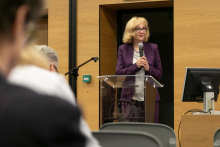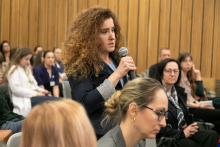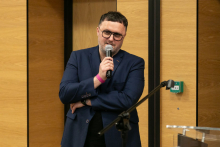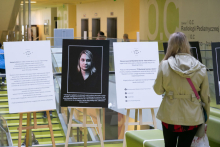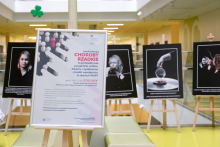As explained by dr hab. Krzysztof Szczałuba, Director of the Center of Excellence for Rare and Undiagnosed Diseases of the Medical University of Warsaw, the host of the symposium titled “Rare diseases from the perspective of patients, families, doctors and caregivers – a model of cooperation within the Medical University of Warsaw”.
“The aim of the event is to attract patient and parent organizations, foundations and associations into the orbit of the MUW’s activities in the field of rare diseases and to present the MUW as a leading center for activities for the benefit of these organizations. It is here, at the MUW, that we are able to ensure continuity of medical care for patients with rare and undiagnosed diseases throughout their lives and guarantee them multi-disciplinary treatmen. Comprehensive and interdisciplinary preparation for genetic care for patients with rare diseases at the MUW significantly improves the quality of life of sick people.”
About the importance of the conference and the MUW’s activities in the field of rare diseases
“The MUW has been conducting scientific research on pathogenesis, innovative diagnostics and innovative methods of therapy for patients with rare diseases for many years,” said Rector prof. Zbigniew Gaciong, and added: “Approaching the topic of rare diseases from the perspective of people, society, loved ones and those who care for patients with rare diseases is extremely valuable and will allow not only to ensure the highest standard of care for these people, but also promote the treatment of rare diseases and their appropriate diagnostics. Today we want to listen to the voices of families and caregivers so that we can respond to their needs even better. It is also an opportunity to strengthen cooperation between our university and many patient and parent organizations, foundations and associations.”
Also prof. Piotr Pruszczyk, Vice-Rector for science and technology transfer, spoke about the importance of the conference and the MUW’s activities in the field of rare diseases. He pointed out that at our university and in our hospitals we have multidisciplinary therapeutic opportunities for patients with these diseases, as well as research opportunities – to discover new mutations and pathomechanisms of the development of these diseases.
“I am very glad to participate in this next meeting of the Center of Excellence for Rare and Undiagnosed Diseases, which is a platform combining many different diagnostic, therapeutic and research trends related to the great challenge of rare diseases,” said prof. Pruszczyk.
On systemic challenges in rare diseases
Stanisław Maćkowiak from the Federation of Polish Patients and the “Orphan Poland” Foundation presented the conference participants with a historical outline of the work on the “Plan for Rare Diseases”. “Plan for Rare Diseases” He noted that despite the involvement of many people and the establishment of expert teams working on solutions related to the implementation of the tasks outlined in the “Plan”, no legislation has been adopted that would allow for further systemic work in the field of rare diseases. He also talked about the need to mobilize financial resources to create a Polish reference network. This is crucial for patients because the network will provide comprehensive care. There are 46 reference centers in Poland that could be included in the network. And as the speaker emphasized, they are at a very high level, both substantive and organizational, and they also met the high criteria set by European networks.
Also prof. Anna Kostera-Pruszczyk, Head of the Department and Clinic of Neurology at the University Clinical Center of the Medical University of Warsaw, also spoke about the “Plan for Rare Diseases”:
“I would really like all of us here – patients, clinicians, diagnosticians, the Ministry of Health – to make rare diseases a priority, so that our patients could finally become equal participants in the health system.”
According to prof. Kostera-Pruszczyk, organizing the care of these patients means relieving the burden on a patient suffering from a rare disease, thus relieving the system and making room for other patients. It is equally important to ensure health security for patients throughout their lives.
The “Plan for Rare Diseases” is needed because, as emphasized by prof. Kostera-Pruszczyk, doctors are unable to provide patients with the highest diagnostic and therapeutic standard without all the necessary tools – medical, systemic and financial. She recalled that, when Poland adopted the “Plan” in 2021, it was one of the last two EU countries that did not have it yet. She added that the “Plan” has expired but there is an assurance from the Ministry that work on it will be resumed.
“And the solutions are on the table,” said prof. Kostera-Pruszczyk. “These are not spontaneous ideas. They are solutions based on the experience of other, very good, foreign centers.”
Finally, prof. Anna Kostera-Pruszczyk presented the symbol of rare diseases to the audience: a zebra. Why this particular animal?
“Well, as they say, when we hear the hoofbeat we usually think of a horse, not a zebra. And this is what they teach us from the beginning at the university: to think about common issues, the more probable ones. Well, no. Let’s think about zebras,” she explained.
The voice of the Ministry
The opening of the symposium was also attended by the Deputy Minister of Health, prof. Urszula Demkow, who said:
“We are working on system solutions. I really want to create a register of rare diseases. It is important to know how many diseases there are, what specific symptoms they cause and how the diagnostics works. There is a plan, but the most important thing is money. Today I have good news, because they are there.”
The Deputy Minister emphasized that there are no answers to all problems yet but she mentioned, for example, the continuation of the activities of the Council for Rare Diseases, as well as the pending enactment of a law on genetic testing.
“I am from the Medical University of Warsaw. For many years I ran a laboratory diagnosing rare diseases, among others,” she emphasized. “I was also the head of the genetics department and I worked with many doctors. We aimed to diagnose rare diseases, so I know how difficult and long this process is; how long and bumpy the road awaits patients and their caregivers.”
Experts – clinicians and diagnosticians
Presentations at the symposium were delivered by employees of the MUW’s units dealing with rare diseases: dr hab. Krystyna Szymańska, dr hab. Piotr Skrzypczyk, dr Marek Karwacki, prof. Krzysztof Jamroziak, prof. Piotr Milkiewicz, prof. Wojciech Lisik, prof. Anna Kostera-Pruszczyk, prof. Agnieszka Szypowska, prof. Bożena Werner, prof. Tomasz Stokłosa, prof. Rafał Płoski, prof. Grzegorz Basak, mgr Artur Bartochowski, mgr Anna Rakowska, dr Katarzyna Kuśmierska and dr eng. Anna Sibilska-Mroziewicz from the Warsaw University of Technology.
Patient organizations
Patients suffering from a rare disease often struggle with a lack of understanding, appropriate diagnosis, care and treatment. Therefore, one session of the conference was entirely devoted to the experiences of patient organizations. The following spoke during the meeting: Marcin Basiński – “We Have Hit the Wall” Foundation; Małgorzata and Piotr Kośla – “PACS2 Research” Foundation; Dorota Raczek and Katarzyna Gągor-Nowak – “SMA” Foundation; Dorota Korycińska – “Neurofibromatosis Poland” Association; Marek Piegat – National Association for Assistance to People with Rett Syndrome; Aneta Jurko – Association of Patients with Tuberous Sclerosis; Iwona Czabak – “Marfan Poland” Association; Marzena Piejko – “CF Breath of Life” Foundation.
“Imagine that you want to say something and communicate with your loved one. You can’t do that because you are unable to utter articulate sounds. You want to button up but you can’t because your hands won’t let you do it. What remains is screaming and frustration. This is what life with Rett syndrome is like,” explained during the conference, Marek Piegat, the father of a girl suffering from this disease.
As it was said during the meeting, unfortunately, not everywhere in Poland the knowledge and awareness of rare diseases among medical staff is sufficient. That is why some patients choose an independent and individual path. Małgorzata and Piotr Kośla, parents of two-year-old Lenka suffering from PACS2, talked about their struggles with this rare disease during the conference. Lenka’s disease is epileptic and developmental encephalopathy 66 caused by a mutation in the PACS2 gene. For simplicity, we simply call the disease “PACS2 Syndrome.” The disease means epilepsy, cerebellar dysgenesis, global developmental delay, intellectual disability and, usually, behavioral disorders (autism). The prognosis is unclear – the course of the disease varies greatly, even though patients have exactly the same mutation. Only about 100 people are diagnosed worldwide, mostly children. Within 3 days they managed to reach the first and only Polish family of a boy with the same disease. Then they found an international group of families and read all existing publications about the sick, although there was nothing about the disease itself.
“In May 2022 we established the ‘PACS2 Research’ Foundation and began to set our plan to develop a drug for PACS2 syndrome. In less than 3 years we should have the initial real clues about what the mutation ‘damages’ in the body and how it specifically affects the development of neurons,” said Małgorzata Kośla.
Expert advice and workshops
Participants of the conference could also benefit from advice from specialists – pediatric neurologist dr Anetta Jeziorek, pediatric oncologist dr Marek Karwacki, pediatric nephrologist dr hab. Piotr Skrzypczyk, pediatric cardiologist dr hab. Tomasz Książczyk and pediatric diabetologist dr Jędrzej Nowaczyk – and from rehabilitation workshops conducted by Artur Bartochowski and dietary workshops led by dr Magdalena Milewska.
Photographic exhibition
The event is accompanied by the exhibition titled “Face to face with myasthenia” which presents the symptoms of a rare neurological disease – myasthenia gravis belonging to the group of neuromuscular disorders. About 9,000 people suffer from it in Poland.
The challenge for myasthenics is even simple everyday activities that are trivial for a healthy person, such as buttoning up, typing on a keyboard, getting into a bathtub or getting up from a chair. Climbing stairs, driving a car, speaking and eating is very difficult because even the slightest effort weakens the muscles. The disease is unpredictable, variable, capricious, and may worsen suddenly.
The exhibition can be viewed until March 8 on the ground floor of the Children’s Clinical Hospital of the the University Clinical Center of the Medical University of Warsaw. The organizer is the “Myasthenia Gravis – Face to Face” Association.
About the co-host – the “We Have Hit the Wall” Foundation
The Foundation was established in 2022 and currently has approximately 20,000 members. It continues the activities of the parental support group founded in 2018 by Marcin Basiński, the father of a boy suffering from the ultra-rare HIBCH disease. Using its own experience and the knowledge of cooperating specialists, the Foundation shortens the diagnostic odyssey of many families. The Foundation is a platform for communication and cooperation between patients, doctors and scientists. It works to develop genetic research, both diagnostic and scientific. It offers comprehensive support for families with children suffering from rare diseases.
The conference titled “Rare diseases from the perspective of patients, families, doctors and caregivers – a model of cooperation within the Medical University of Warsaw” preceded the “Rare Diseases Day” celebrated every year on the last day of February. The day was established by the European Federation of Parents of Patients and Patients with Rare Diseases (EURORDIS) to raise awareness of these diseases and build solidarity with those affected.
